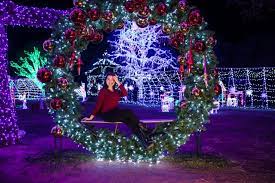Every year, as the holiday season approaches, streets and homes become adorned with vibrant decorations. Amongst the twinkling lights and festive ornaments, there is one particular color that stands out: blue. Blue Christmas lights have gained popularity in recent years, captivating the attention of both decorators and passers-by. However, there is a deeper meaning behind their symbolic power, as they represent more than just decoration; they bring comfort, hope, and awareness during what can be a difficult time for many individuals.
Christmas is often associated with joy, happiness, and togetherness. But for a significant number of people, it can also be a time of sadness, loneliness, and grief. These blue lights serve as a visual reminder of these emotional struggles, providing reassurance and a sense of understanding. Blue, traditionally associated with calmness and tranquility, can help instill a sense of peace and serenity during a time that can be overwhelming.
The symbolic power of blue Christmas lights extends beyond personal emotions, reaching out to shed light on important societal issues. The color blue is recognized as the international symbol for autism awareness. During the holiday season, blue lights are often used to raise awareness about autism spectrum disorder (ASD) and show support for those who are affected by it. By illuminating their homes or businesses with blue lights, individuals and communities bring attention to this developmental disorder and promote inclusivity and understanding.

Moreover, blue lights also serve as a reminder of the sacrifices made by our military personnel. In many countries, blue is designated as the color to honor those serving in the armed forces, especially during the holiday season. By adorning their homes or public spaces with blue lights, individuals pay tribute to the brave men and women who protect their nations, even when they are far away from their families and loved ones.
Blue Christmas lights also hold significance within the context of mental health. They act as a visual representation of solidarity and support for individuals struggling with mental illness, helping to break down the stigma surrounding these conditions. The blue lights create a safe and non-judgmental environment, reminding those who may be suffering that they are not alone during a time that can exacerbate feelings of isolation.
Additionally, blue Christmas lights can bring forth a sense of nostalgia and remembrance. As we grow older, the holiday season often becomes a reminder of loved ones who are no longer with us. The blue lights stand as a symbol of remembrance, honoring the memories of those who have passed away. They serve as a gentle reminder that even in the absence of physical presence, their spirit continues to shine bright.
In recent years, blue Christmas lights have become a beacon of hope. They provide a sense of comfort and understanding, creating an atmosphere of compassion and support for those who may feel overwhelmed. Their symbolic power reaches beyond aesthetics, encompassing significant societal issues such as autism, mental health, and honoring the sacrifices of military personnel.
The Gift Dilemma: Insights and Advice for Handling a Disappointing Christmas
As we stroll through streets adorned with blue lights during the holiday season, let us be reminded to embrace the deeper meaning they hold. Let us use them as a catalyst for fostering inclusivity, understanding, and empathy towards those who may be struggling. In the spirit of the holiday season, may these blue lights serve as a reminder to spread kindness and support to all, keeping the symbolic power they carry alive not only during Christmas but throughout the year.


Add a Comment